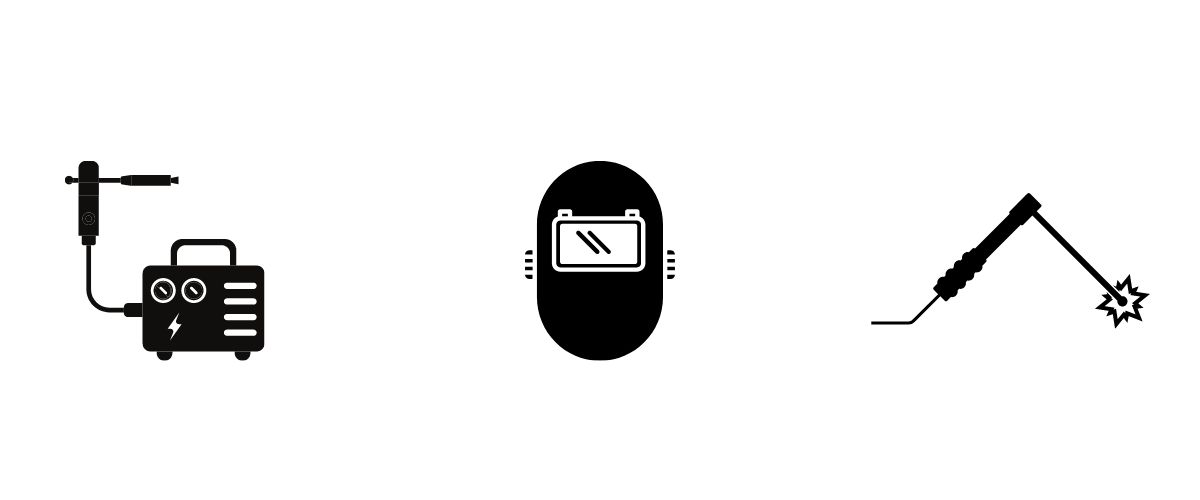
Welding involves the use of high heat tools to bond pieces of metal and thermoplastic together when creating furniture, tools, machinery, and components of scientific and industrial equipment among many other items. A highly technical task, welders train for years to become masters at their craft and utilize a variety of tools and equipment to create high-quality results safely and efficiently.
Because welders use high heat tools that involve open flame, safety is of the utmost importance, which can be facilitated by a combination of equipment, proper procedure, and environmental conditions.
In addition to the safety of the facility, welders are responsible for their safety and the safety of facility personnel, which is why welders utilize a variety of safety equipment to protect themselves from burns, bright light, and fumes. If you are in the process of setting up your own welding workstation, you will need to equip yourself with the appropriate PPE and general tools to successfully perform the job.
Here, we’ve created a basic list of all the equipment you will need to safely weld any project.
Welding PPE
Personal protective equipment (PPE) is perhaps the most important factor for enhancing the productivity and safety of welders in the workplace, since, without it, they could be exposed to extreme heat conditions that can cause serious discomfort or injury. Safely protected by welding PPE, welders are free to concentrate on the task at hand without worrying about their eyesight, their skin, their hair, or their clothing. Here are just some of the essential pieces of PPE welders value most:
Welding Goggles
Welding goggles protect your eyes from ultraviolet and infrared light waves, plus provide added physical protection against sparks or flying debris. Additionally, welding goggles help to reduce the impact of radiating heat on your sensitive eyes, also covering the eyebrows to prevent them from becoming singed.
While welding goggles provide a certain amount of protection for small projects (specifically gas welding projects), larger more intensive projects (like arc welding projects) may require more extensive face, eye, and head protection.
Welding Face Shields
If you feel most comfortable welding in goggles, but need extra protection from heat, debris, and flying sparks, a welding face shield can be worn over your goggles to protect the entirety of your face and neck. Wearing a welding shield can allow you to get closer to projects for better visibility, and protect the parts of your face not protected by welding goggles.
Welding Helmets
Welding helmets, sometimes called welding hoods, are a more heavy-duty alternative to the goggle and shield combo. Welding helmets provide superior protection from UV and ultraviolet rays and protect both the front, top, sides, and bottom of your face from sparks or debris.
Basic welding helmets are lightweight, comfortable for all-day wear, and provide enough protection to keep your eyes safe even after hours of welding.
For welders that need protection against extremely high heat or brighter light, some welding helmets are designed with auto-darkening features that detect the brightness of what you are looking at and instantly turn black when an arc appears. Once your welder is turned off, the helmet will automatically allow visibility again.
Ear Protection
Welding can be loud, and while short bursts may not impact hearing, extended exposure can cause significant hearing loss and even cell damage at certain frequencies. Additionally, many facilities where welders work pose other noise hazards, so wearing hearing protection is necessary for safe operation.
Earplugs or overhead ear muffs are appropriate depending on the volume of the noise.
Welding Respirators
The residue and fumes produced during the process of welding may be hazardous to human health and could increase the risk of an individual contracting health conditions like bronchial asthma or lung cancer. Welding respirators help to filter out toxins while providing a fresh supply of air to protect your lungs while welding.
Welding Gloves
A welder’s hands get very close to the tools they work with and the projects they work on, which is why it is important to wear heavy-duty welding gloves. Welding gloves provide protection from heat, flame, sparks, and flying debris while still allowing for enough flexibility to make precise movements.
Welding Jackets
Welding jackets cover the entire torso, protecting clothing from sparks, smoke, and residue, and protecting the welder from injury. Much thicker than traditional jackets, welding jackets are flameproof, thick enough to prevent debris from piercing through, and prevent overheating.
Welding Aprons
Welding aprons cover the front of the torso and the legs, providing protection from oncoming sparks. Though less protective than a jacket, welding aprons used in conjunction with gloves can provide ample protection for smaller projects.
Welding Boots
Welding boots help to protect the feet from sparks, heat, and flying debris, but also offer extra support to protect the wearer’s toes from heavy objects that may drop or fall.
Welding Tools
Welding is unique in that it requires only a few tools to be done successfully, so if you are newly setting up a welding station or facility, you won’t need to invest in much to get started. In addition to the necessary PPE, you’ll need the following welding tools:
Welder
The welder itself is the first piece of equipment most welders invest in, with Metal Inert Gas (MIG) welders being the most common choice. Welders come in a variety of sizes and price points, with many available in small, easily portable forms.
Angle Grinder
An angle grinder is one of the best tools for making cuts and preparing edges for welding. With various disk sizes available, angle grinders are a versatile tool that every welder needs in their toolkit.
Welding Pliers
Welding pliers help you to grip pieces when they are hot and can be used to stabilize various components of whatever you are building. Welding pliers can also be used to form and shape thermoplastics and formable metal components.
Clamps & Magnets
Clamps and magnets are used to attach items to a welding table for the purpose of keeping them still and in one place for the duration of the task. Welding clamps and magnets should be chosen based on the specifications of your particular welding table.
Welding Tables
Welding tables are raw steel platforms that provide a surface on which to perform welding projects. Heatproof to prevent flexing or any movement, welding tables are designed for the ultimate stability to enhance the accuracy of your work. At OnePointe Solutions, we give our customers the opportunity to design their own custom welding tables that feature the key tools and accessories they need.
Designed and built in the U.S., welding tables created by OnePointe Solutions are of the highest quality, and made to the specifications of each client.
Need a Welding Table?
Visit us online or give us a call at (866) 222-7494 to get started today!


